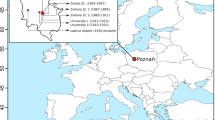Abstract
The derivatives of the annual average temperature are analyzed based on data from 927 weather stations of the Northern Hemisphere from 1955 to 2016. Changes in the derivatives are considered as manifestations of the emergent property of the holistic climate system. A measure for these manifestations is introduced. It has a form of a functional which includes averaging of positive and negative derivatives and calculation of their correlation coefficients. It is established that the sampling distribution of sums of opposite extreme values of derivatives of the annual average temperature is symmetric and has a larger kurtosis than a normal distribution. In the period under study, the values of the measure are already close to their limit values. Therefore, annual estimation of changes in the measure of emergent properties in the multichannel monitoring system is necessary.


Similar content being viewed by others
REFERENCES
I. Prigozhin, Introduction in Thermodynamics of Nonequilibrium Processes (Inostr. literatura, Moscow, 1960) [in Russian].
L. von Bertalanffy, General System Theory—A Critical Review (Society for General Systems Research, 1962).
B. G. Sherstyukov, “Possible resonance mechanism of climate oscillations,” Proc. RIHMI-WDC, Is. 181, 52–70 (2018).
B. G. Sherstyukov, “Resonances in the Solar system and climate variations,” Slozhnye Sistemy, No. 3, 31–48 (2018).
A. V. Byalko, N. I. Vaganova, and E. N. Rumanov, “About possible climate instability, Dokl. Rus. Akad. Nauk 431 (5), 617–620 (2010).
IPCC, 2013: Climate Change 2013: The Physical Science Basis. Contribution of Working Group I to the Fifth Assessment Report of the Intergovernmental Panel on Climate Change, Ed. by T.F. Stocker, D. Qin, G.-K. Plattner, M. Tignor, S.K. Allen, J. Boschung, A. Nauels, Y. Xia, V. Bex, and P.M. Midgley (Cambridge University Press, Cambridge, United Kingdom; New York, USA, 2013).
Climate Variability and Extremes during the Past 100 Years, Ed. by T. Brönnimann, J. Ewen, J. Luterbacher, H. F. Diaz, R.S. Stolarski, and U. Neu (Springer, Dordrecht, 2008).
C. Simol, M. Brunetti, M. Maugeri, and T. Nanni, “Evolution of extreme temperatures in a warming climate,” Geophys. Res. Lett. 38, L16701 (2011). https://doi.org/10.1029/2011GL048437
S. Rahmstorf and D. Coumou, “Increase of extreme events in a warming world,” Proc. Natl. Acad. Sci. USA 108 (44), 17 905–17 909 (2011). https://doi.org/10.1073/pnas.1101766108
M. G. Donat, L. V. Alexander, H. Yang, I. Durre, R. Vose, R. J. H. Dunn, K. M. Willett, E. Aguilar, M. Brunet, J. Caesar, B. Hewitson, C. Jack, A. M. G. Klein Tank, A. C. Kruger, J. Marengo, T. C. Peterson, M. Renom, RojasC. Oria, M. Rusticucci, J. Salinger, A. S. Elrayah, S. S. Sekele, A. K. Srivastava, B. Trewin, C. Villarroel, L. A. Vincent, P. Zhai, X. Zhang, and S. Kitching, “Updated analyses of temperature and precipitation extreme indices since the beginning of the twentieth century: The HadEX2 dataset,” J. Geophys. Res.: Atmos. 118, 2098–2118 (2013).
S. M. Papalexiou, A. AghaKouchak, K. E. Trenberth, and E. Foufoula-Georgiou, “Global, regional, and megacity trends in the highest temperature of the year: Diagnostics and evidence for accelerating trends,” Earth’s Future 6, 71–79 (2018).
B. P. Korol’kov, Thermodynamic Foundations for Self-Organization (IrGUPS, Irkutsk, 2011) [in Tussian].
http://metoffice.gov.uk, http://cru.uea.ac.uk. Cited August 1, 2020.
P. D. Jones, D. H. Lister, T. J. Osborn, C. Harpham, M. Salmon, and C. P. Morice, “Hemispheric and large-scale land-surface air temperature variations: An extensive revision and an update to 2010,” J. Geophys. Res. D 117 (5), D05127 (2012). https://doi.org/10.1029/2011JD017139
I. Harris, T. J. Osborn, P. Jones, and D. Lister, Version 4 of the CRU TS monthly high-resolution gridded multivariate climate dataset Sci. Data 7 109. Cited August 1, 2020.https://doi.org/10.1038/s41597-020-0453-3
T. J. Osborn and P. D. Jones, “The CRUTEM4 land-surface air temperature data set: Construction, previous versions, and dissemination via Google Earth,” Sci. Data 6, 61–68 (2014).
M. N. Koshlyakov and R. Yu. Tarakanov, “Water transport across the subantarctic front and the global ocean conveyer belt,” Oceanology 51 (5), 721–735 (2011).
R. S. Vose, D. Andt, V. F. Banzon, D. R. Easterling, B. Gleason, B. Huang, E. Kearns, J. H. Lawrimore, J. M. Matthew, T. C. Peterson, R. W. Reynolds, T. M. Smith, C. N. Williams, Jr., and D. B. Wuertz, “NOAA’s merged land-ocean surface temperature analysis,” Bull. Am. Meteorol. Soc. 93, 1677–1685 (2012).
Yu. P. Perevedentsev and K. M. Shantalinskii, “Measurements of surface air temperature in the Northern hemisphere for 1850–2014,” Uchenye Zapiski Kazanskogo Univ. Ser. Estestvennye Nauki 157 (3), 8–19 (2015).
G. V. Alekseev, “Development and amplification of global warming in the Arctic,” Fund. Prikl. Klimatolog. 1, 11–26 (2015).
J. E. Walsh, “Intensified warming of the Arctic: Causes and impacts on middle latitudes,” Glob. Plan. Change 117, 52–63 (2014).
H. W. Dove, Die Verbreitung der Warme auf der oberflache der Erde: Erlautert durch Isotermen, thermische Isanomalen und Temperaturcurven (Verlag for Dietrich Reimer, Berlin 1852).
J.-Sh. Ye, Y. H. Gong, F. Zhang, J. Ren, X.-K. Bai, and Y. Zheng, “Which temperature and precipitation extremes best explain the variation of warm versus cold years and wet versus dry years?,” J. Clim. 31, 45–59 (2018).
Funding
This work was supported by the Ministry of Science and Higher Education of the Russian Federation (Institute of Monitoring of Climatic and Ecological Systems, Siberian Branch, Russian Academy of Sciences).
Author information
Authors and Affiliations
Corresponding author
Ethics declarations
The authors declare that they have no conflicts of interest.
Additional information
Translated by A. Nikol’skii
Rights and permissions
About this article
Cite this article
Tartakovsky, V.A., Cheredko, N.N. & Maksimov, V.G. Emergent Properties of a Climate System: Derivatives of Annual Average Temperature at Weather Stations of the Northern Hemisphere. Atmos Ocean Opt 34, 341–346 (2021). https://doi.org/10.1134/S1024856021040138
Received:
Revised:
Accepted:
Published:
Issue Date:
DOI: https://doi.org/10.1134/S1024856021040138




